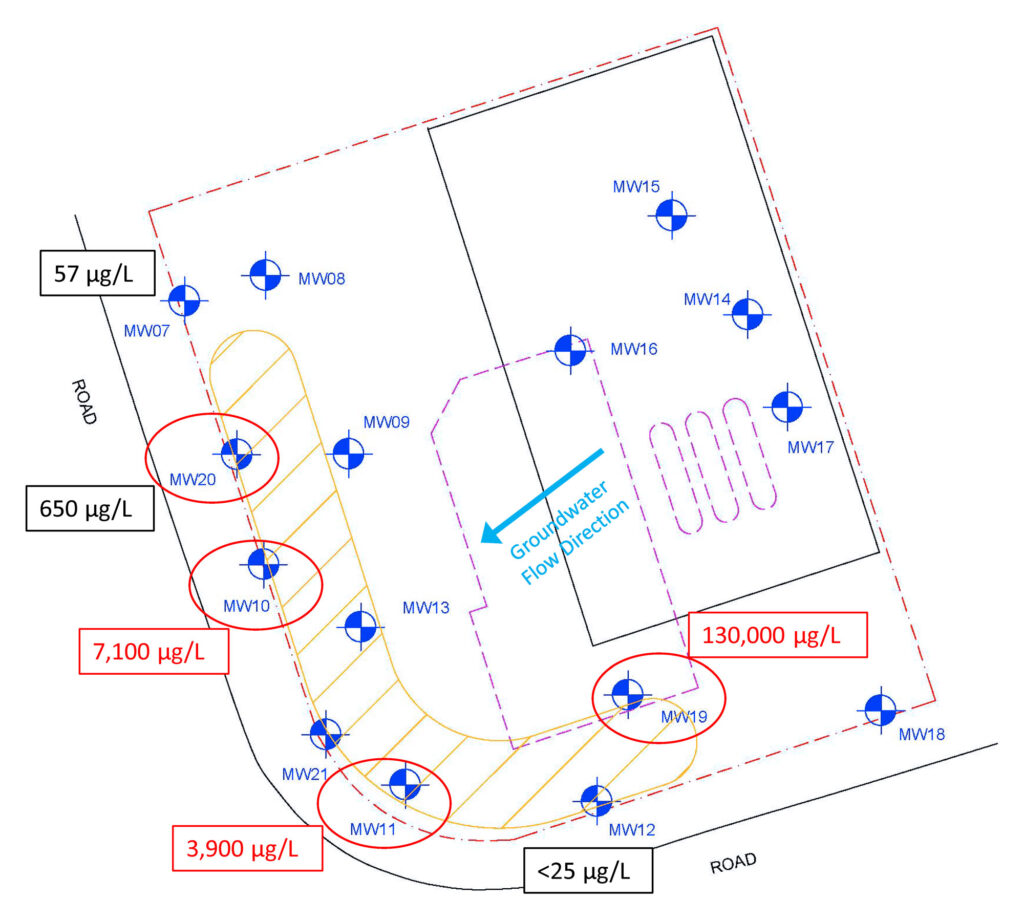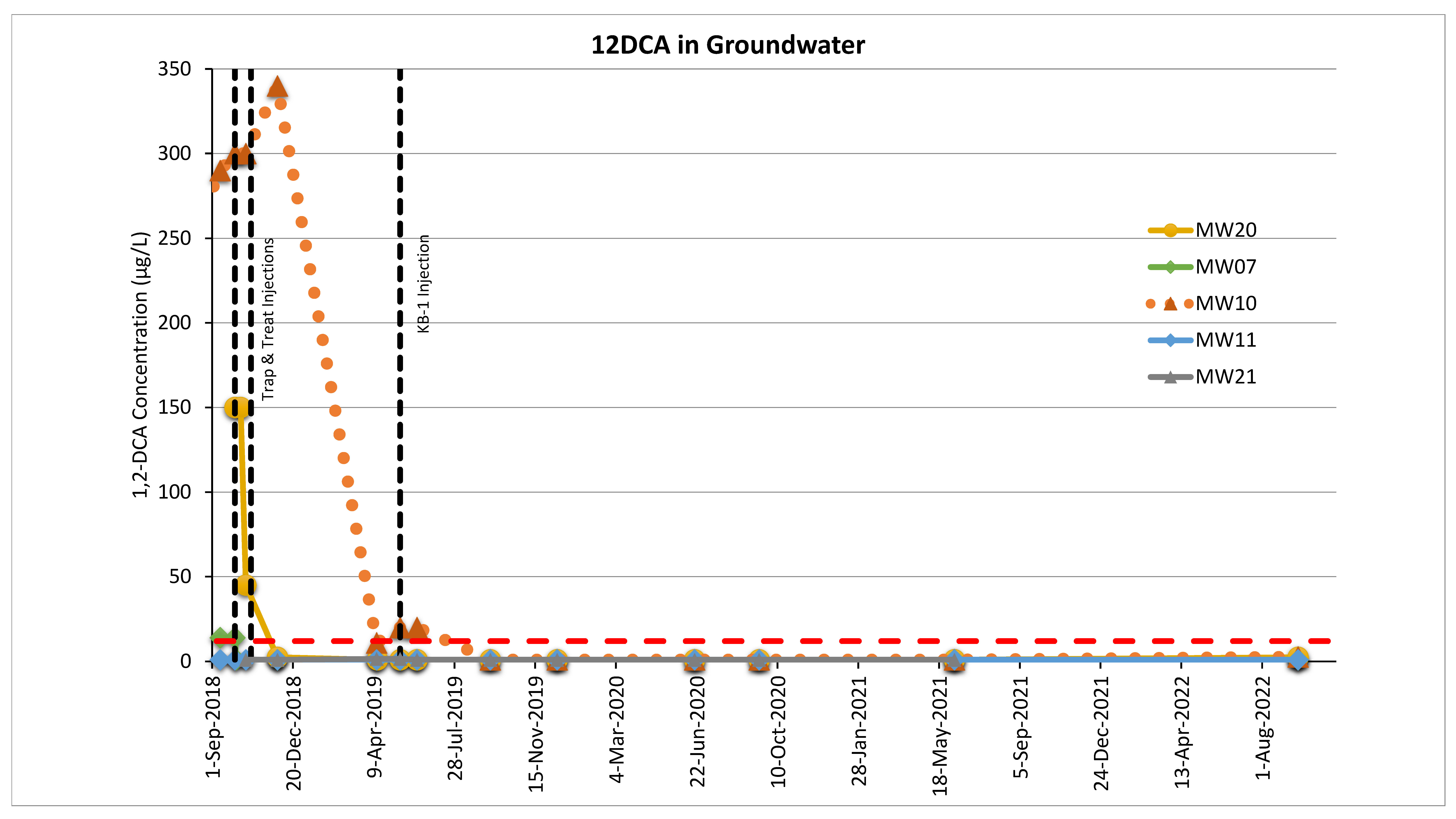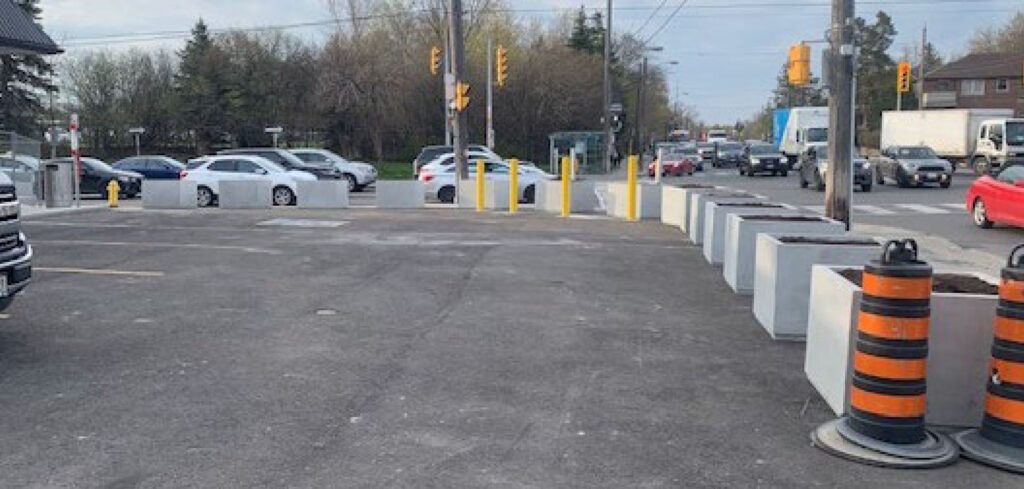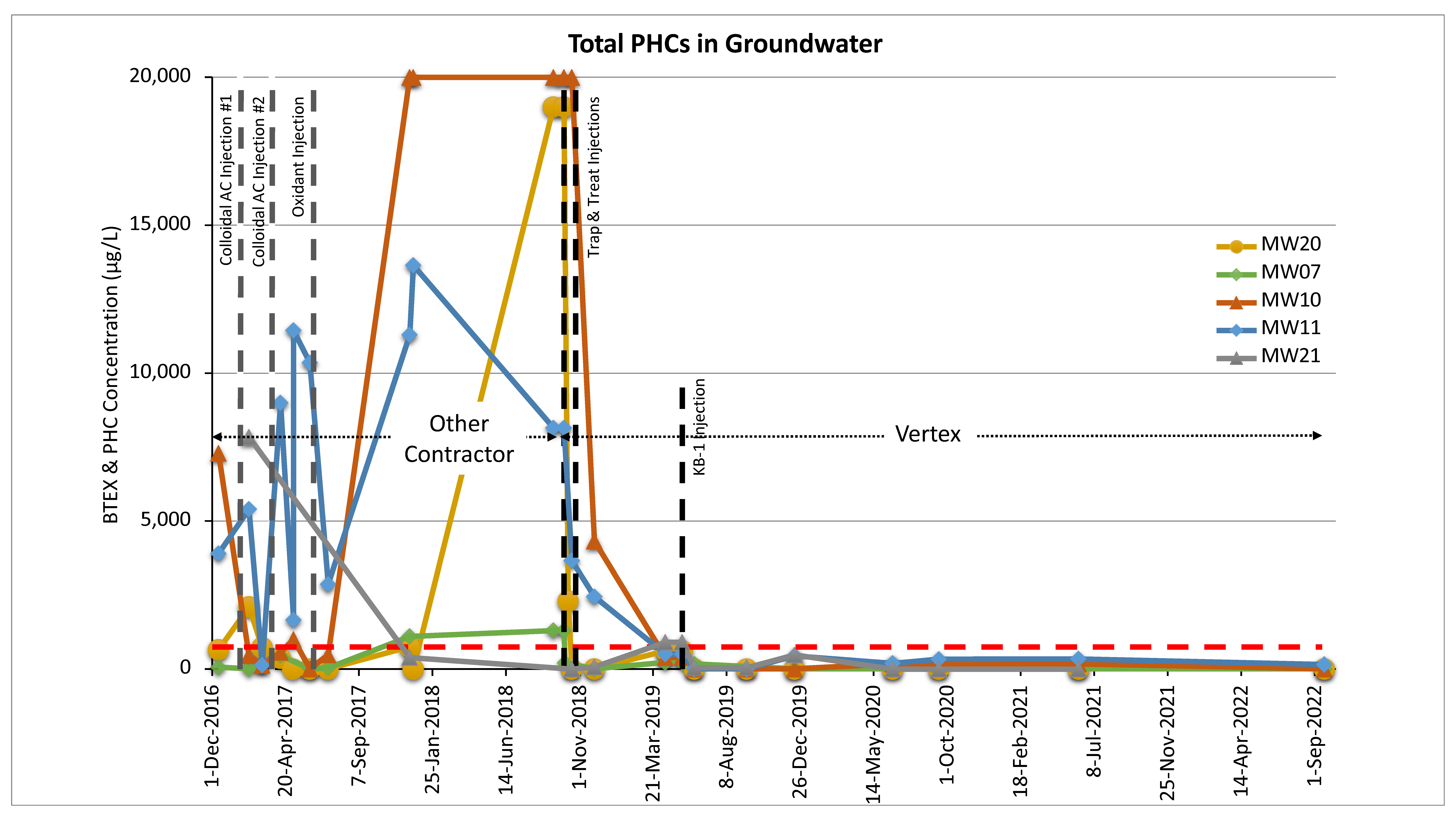Case Study: When In-Situ Techniques Fail
A recent trend we’ve seen in the environmental remediation sector relates to a significant uptick in popularity of using Permeable Reactive Barriers (PRBs) as a Risk Management Measure (RMM) at impacted sites in Canada. But what happens when PRBs start to fail, or never work as intended from the start? Is there a way to identify why failure occurred and/or how to fix it? Better yet, is there a way to avoid failure in the first place?
The answer to all these questions is: YES!
The following case study attempts to identify common factors that can lead to the failure of an in-situ remediation program and how mistakes can be avoided in the first place or repaired if they do happen to occur. After all, PRBs, when designed and installed properly, are awesome and we love them!

Recent advances in remedial amendments used to treat plumes of heavy metals, chlorinated solvents (CVOCs), petroleum hydrocarbons (PHCs) and, most recently, per- and polyfluoroalkyl substances (PFAS) compounds in groundwater have likely contributed to the increased popularity of PRBs. The increased adoption and acceptance of Risk Assessment (RA) approaches to managing impacted sites, frequently incorporating RMMs such as PRBs and Soil Vapour Intrusion Mitigation Measures (SVIMMs), has also helped. It should be no surprise then that Vertex has spent a considerable amount of time and effort promoting the virtues of PRBs in past newsletters and at conferences and has developed the capabilities to install injected PRBs for a wide variety of contaminants in all geologies.
But sometimes all is not rosy in PRB land. Let’s now turn to the Site in question for this case study where a PRB was needed to intercept and treat a plume of PHCs at an urban property slated for eventual redevelopment.
Background
A large REIT (real estate investment trust) was purchasing individual properties to assemble a larger parcel of land in a major Canadian city. The Site in question was the key corner lot that had formerly operated as a retail gasoline station for over 50 years and contained multiple former underground storage tanks (USTs) and fuel dispensing pumps in different areas over its long history. Not surprisingly there was a significant amount of PHC contamination present in the subsurface, mostly comprised of the BTEX parameters (benzene, toluene, ethylbenzene and xylenes) and F1 range PHCs, with a little bit of 1,2-dichloroethane thrown in for good measure.
A PRB for PHCs was needed on the downgradient property line. But due to Site access constraints, adjacent off-Site underground services, and the depth to the groundwater, the PRB had to be installed by injection.

Site Layout and Proposed PRB Alignment
The subsurface impacts at the Site were considerable. These included numerous instances of PHC-related sheens and free-phased product including light, non-aqueous phase liquid (LNAPL) observed during borehole drilling and soil sampling, as well as during monitoring well purging activities. The following figure notes the F1 range PHC concentrations in groundwater in selected monitoring wells at the Site as well as the locations where PHC-related sheens and/or LNAPL were observed (circled in red).

PHC Concentrations in Groundwater and Observations of Sheen/LNAPL
First Attempt(s) at the Injected PRB (by another Contractor)
Prior to Vertex’s involvement, another remediation contractor was retained to design and install an injected PRB for PHCs at the Site. Their recommended approach was to install an injected PRB comprising a Colloidal Activated Carbon (Colloidal AC) product to adsorb the PHCs, combined with an Oxygen Releasing Material (ORM) to facilitate aerobic degradation of the PHCs. The overall objective of the PRB was to treat groundwater leaving the Site to a point where it met the generic regulatory standards.
Their PRB injection program was completed as planned. Post-injection groundwater monitoring results were less than desirable, so a secondary, similar injection event was proposed and completed. Once again, the results were not stellar. Finally, a third injection event was completed. In total the following injection activities took place in attempts to install a functional PRB for PHCs at the Site.

Summary of Injection Activities Completed for Attempted PRB for PHCs by Another Contractor
The following animation shows the results of the groundwater monitoring activities before, during and after the initial attempts to install an injected PRB for PHCs at the Site by the other contractor.
Groundwater Monitoring Results for Attempted Injected PRB by Another Contractor
As is (somewhat painfully) obvious in the post-injection groundwater monitoring results shown above, this injected PRB did not perform according to the project objectives and, arguably, may have even exacerbated subsurface contamination conditions at the Site.
So, what went wrong?
There are many ways that an in-situ remedial injection program can fail. A list of some of the more common reasons includes:
- Incomplete understanding or disregard of contaminant concentration and/or distribution (sheens, LNAPL, etc.);
- Selection of the wrong remedial technology and/or the order of application;
- Under-dosing the remedial amendment(s);
- Poor contact and/or distribution of the remedial amendments in the subsurface;
- Working against baseline geochemistry;
- Not considering the age of the contamination;
- Unknown or poorly understood soil and/or bedrock characteristics;
- Uncertainties in the groundwater flow velocity; and/or
- Ignoring seasonal water table fluctuations, etc.
In this case it appears that the first five factors highlighted in bold font above likely contributed to the failure of the original PRB at the Site.
Second Attempt at the Injected PRB (Vertex’s Approach)
The client subsequently retained Vertex to see if we could satisfy the project objective of installing an injected PRB at the Site to treat the PHCs in groundwater to the generic regulatory standards.
As with all PRBs, the Vertex design focused on ensuring excellent horizontal and vertical coverage of the treatment amendment. You can see the wider coverage (more injection points) and better vertical coverage compared to the first attempted PRB injection here:
| Parameter |
Colloidal AC Injection #1 (Another Contractor) |
Trap & Treat® Injection (Vertex Environmental) |
| Injection Date | January 2017 | September 2018 |
| Reported PRB Dimensions | 24 m long by 3 m wide | 25 m long by 3 m wide |
| Number of Injection Points | 24 | 81 |
| Injection Details – Lateral | 1 Row, 1 m spacing | 3 Rows, 1 m spacing |
| Injection Details – Vertical | 3 discrete vertical intervals | 9 discrete vertical intervals |
| Main Remedial Amendment | Dilute Colloidal AC solution | Concentrated Powdered AC slurry |
| Bio-Enhancement | Oxygen Release Material | Nutrients, Sulphate and Microbes |
Comparison of Original and Updated Proposed Approaches for the Injected PRB
There were many significant differences between Vertex’s design and the other contractor, with the three most significant being:
- Installation Approach: Many more injection points were used by Vertex to create the PRB, using significantly more discrete vertical injection intervals. This approach results in excellent distribution of the remedial amendment.
- Remedial Amendment Selected: A superior activated carbon-based product was recommended. Trap & Treat® BOS 200® contains much larger activated carbon particle sizes than the very small AC particles found in colloidal carbon. The larger particle size is so beneficial because it allows for robust biological activity to occur on the AC particle. This is key for longer term PRB effectiveness. As a comparison, bacteria that measure 2 to 8 µm long don’t enjoy spending time on an AC particle less than 1 µm in size.
- Enhanced Biological Process Selected: It is well known that oxygen is not very soluble in water and levels are depleted quickly in the subsurface in the presence of PHCs. Why fight this natural process? The use of sulphate to promote long term anaerobic biodegradation is also key to the long-term success of PRBs for PHCs.
The following animation shows the results of the groundwater monitoring activities after Vertex’s re-designed PRB was installed at the Site.
Groundwater Monitoring Results After Vertex’s Re-Designed Injected PRB
To address one area with localized, elevated concentrations of 1,2-dichloroethane (12DCA), the decision was made to address this outlier via a strategic injection of the microbial amendment KB-1®, after which the 12DCA results were also in compliance with the remedial objectives, as shown in the graph below.

12DCA Groundwater Monitoring Results After Injection of KB-1®
When all was said and done the Site surface was reinstated and, as with most in-situ remediation programs, it was difficult to tell that any work was even done!

Injection Area at the Site after Re-Instatement of Asphalt Surface
Lessons Learned
The purpose of presenting this case study is an attempt to identify common factors that can lead to failure of in-situ remediation programs and how mistakes can be avoided in the first place or repaired if they do happen to occur. It appears that in this particular case there were several factors leading to the failure of the original injected PRB for PHCs, including:
- Incomplete understanding or disregard of contaminant concentration and/or distribution (sheens, LNAPL, etc.):
- Evidence of sheens and LNAPL were possibly not taken into account during the original design.
- Selection of the wrong remedial technology and/or the order of application:
- In-situ chemical oxidation (ISCO) was completed after the Colloidal AC injection. Ideally, ISCO is used to destroy contaminant mass in the soil prior to addressing the residual impacts in the groundwater.
- Under-dosing the remedial amendment(s):
- The apparent low mass of Colloidal AC and ORM injected relative to the total mass of PHCs present within the injection zone of the PRB at the Site.
- Poor contact and/or distribution of the remedial amendments in the subsurface:
- An insufficient number of injection points and vertical intervals for an injected PRB to achieve good distribution of the remedial amendments in the subsurface.
- Working against baseline geochemistry:
- It is very difficult to maintain aerobic conditions over the long term based on the solubility of oxygen in water and the oxygen demand required to degrade high concentrations of PHCs.
After a detailed review of all available data for the Site the PRB was re-designed and installed at the Site by Vertex. Now, four years later, groundwater monitoring data shows that the injected PRB is still performing as intended. The plume of PHCs in groundwater leaving the Site has been contained and meets the generic regulatory standards for PHCs, and even the 12DCA.

Long-Term Groundwater Monitoring Results After Vertex’s Injected PRB for PHCs
In summary, it is clear that effective PRBs for PHCs are possible. One just needs to design and install them properly by taking into account the common factors that can lead to the failure of in-situ remediation programs.
For more information about PRBs and/or PHC remediation please contact Vertex (info@vertexenvironmental.ca).

